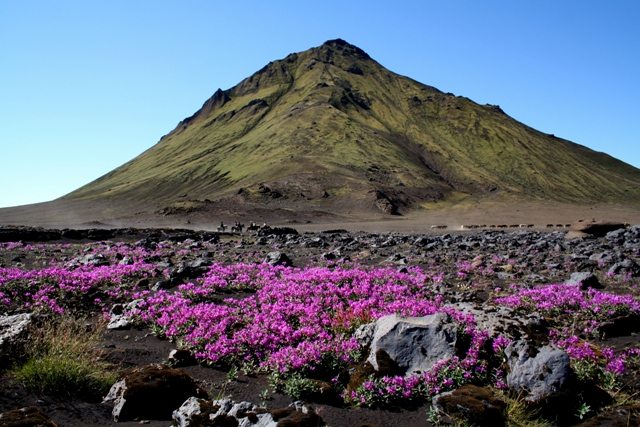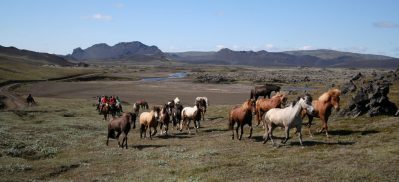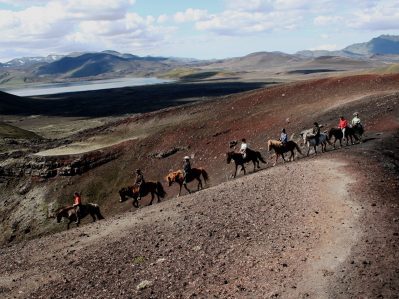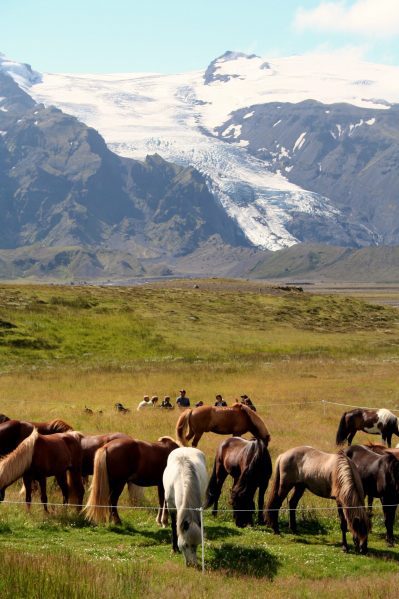My Horse was Norse, of Course
I think, perhaps, that Greenland and Iceland have been misnamed. Well, all right, I have never been to Greenland, but when I visited Iceland in July, I was pleasantly surprised at how very green it is. One of the many aspects of Iceland that has remained with me is that Iceland is a land of contrasts. The island nation is an active volcanic region where plentiful black lava rock and sand in the highlands contrasts sharply with verdant lush farm country in the lowlands. Crystal clear rivers, waterfalls and white glacier faces add yet another dimension to a subtly colored and varied landscape.

I began the 8-day Fjallabak tour by spending a day in the capital city of Reykjavik. Iceland’s Scandinavian heritage is immediately apparent in its architecture and inhabitants. Armed with a guidebook and good walking shoes, one can easily explore the central and historic section of the city near the Tjorn (the Pond) in an afternoon. Because of its relative proximity to North America, most Icelanders speak English in addition to their native Icelandic, and most travel facilities provide information printed in English.
The riding portion of the tour began at the farm belonging to the tour leaders. The entire family who graciously opened their home to us for a delicious mid-day meal warmly welcomed our group. These riding adventures tend to not be dominated by American tourists, but usually provide a congenial mixture of Europeans and North Americans. Riders on this Fjallabak tour hailed from France and Germany in addition to Pennsylvania and Wyoming. Following our meal, we gathered in the warm sunshine by the barn. Broad smiles appeared quickly on our faces as a herd of 38 Icelandic horses cantered into the yard, appearing friendly, curious and eager to start off on a new trek. The majority of the horses used for the tour are raised and trained by the outfitters themselves, so the individual characteristics and personalities of each horse are well known. Each rider was given a saddle and then handed the reins to their new mount and companion. We quickly learned the routine of catching, brushing, saddling and bridling that we were to follow for the next 8 days.
The horses themselves are likely one of the most appealing aspects of visiting Iceland. When Viking voyagers settled the island in the 10th century, they brought with them their most prized possessions…their horses. The breed has remained almost unchanged since that time. The Icelandic horses are renowned for their unique gaits, the “tolt”, a smooth four-beat running walk which enables them to cover rough ground at a quick and comfortable pace, and the “skeid” or flying pace. You will find almost any horse color that you can imagine within the one breed, although chestnuts or sorrels seem to dominate. I was fascinated by those the color of rich black coffee. For many of us, it was our first experience riding Icelandics as we departed from the farm and headed out across grassy pastures. With a little coaching and flawless demonstration by the ride staff, we soon learned how to stretch our torsos upright and stretch our legs down to a fairly long stirrup while supporting the horse just slightly through the bridle to encourage them to tolt. The resulting one, two, three, four, one, two, three, four rhythm became a steady and soothing accompaniment to our ride.

You will find almost any horse color that you can imagine within the one breed, although chestnuts or sorrels seem to dominate.
During the second day of riding the terrain gradually changed from the lower lush farmland to the more rocky and barren highlands. Midway through that day, all of the extra horses that had been led alongside those under saddle were turned loose. They quickly took advantage of their freedom and disappeared in a cloud of dust over the first ridge. However, as soon as we crested that same ridge we found them patiently waiting for us on the other side. During the remainder of the ride the loose horses were constant companions, choosing to travel close to their herd mates. Their presence provided us the opportunity to change mounts mid-day, keeping them fresh and eager to travel.
For the most part, the weather encountered was better than I expected for Iceland. We were blessed with several days of clear blue skies and temperatures reaching 70 degrees in the lowlands. As is typical of the highlands, we also rode for a day through rain showers with a moderate breeze. That same afternoon we reached Landmannalaugar where we enjoyed the open-air hot spring pool. We soaked and chatted and welcomed the heat even as the cool misting rain splashed our heads and faces. Landmannalaugar is one of the larger mountain huts used during the ride. It has several large rooms reserved for use by hiking or riding groups and several campgrounds are located in the vicinity. The facilities are supervised by a warden, whose occupation is similar to that of a park ranger in the States. Our dinner that evening, as on most evenings, began with hot tasty soup and plenty of hearty bread. This was followed by vegetables and one of the products Iceland is justly famous for, fresh succulent baked salmon. We were then treated to the warden’s solo a cappella performance of a traditional Icelandic folk song, his charming way of welcoming us to his homeland.
I had been warned before I set out on this ride, that a strong wind carrying fine particles of abrasive volcanic sand might be encountered, particularly in areas close to the glacier faces. We had spent most of a morning riding across gently undulating hills and ridges before descending onto a flat and sandy landscape. The accompanying vehicle, which carried all of the luggage, food and gear, met the group down on the flat. Here we enjoyed our picnic lunch. A variety of sandwiches were offered, along with fruit, sweets and welcome hot beverages. As we ate and rested, our ride leader looked off across the sandy expanse toward low dark clouds partially obscuring the distant glacier. “Get ready” she warned us, “the wind is going to blow.” We made sure to have gloves on and our hats, jackets and sunglasses securely fastened. A necessary precaution was to have scarves available to draw up over our mouths and noses. We bravely faced the waiting storm as we rode across the black sand toward the glacier. However, what we did not expect, was to ride into a soft and gentle surrounding fog. Its closeness seemed to request silence and subdued the already subtle colors to where it felt as if we had suddenly ridden onto the set of a black and white film. In the quiet blanket of fog we continued on, the steady four-beat rhythm and occasional snort or jingle of reins and bits being the only soft sound.
Accommodations during the ride included two converted farmhouses and five mountain huts, with a different location being used each evening. Most everyone agrees that the mountain hut at Bolstadur has remained in their memories as their favorite lodging. There is something special about descending from a higher rocky plateau where rain is likely encountered to this hut perched on the edge of a gentle green slope overlooking a wide river valley. As soon as the horses had been cared for, we stretched out on the grass to enjoy the warm sunshine and the incredible view of mountains and glaciers in three different directions.
We felt fortunate to have among our group a yoga instructor from Germany. She offered to lead us through a series of stretching and relaxation exercises that were welcome after six days of riding. The consensus was that none of us had ever experienced yoga in a more peaceful, beautiful or unusual location. This hut is more representative of traditional Iceland highland lodging than others we stayed in. During the fall, when the multi-colored sheep are gathered from the surrounding hills, the local farmers often utilize this accommodation. The lower level of the hut includes a simple stable offering protection from the weather for both horses and sheep. The upper level is one large room with bunks and mattresses lined up along two walls, and a small kitchen on one end. A row of tables and benches occupied the center of the room. As was typical of the other mountain huts we stayed in, the building appeared very simple and utilitarian from the outside. However, the inside was warm, clean, and cozy. Large windows on either end of the hut took full advantage of the long daylight hours of mid-summer, not to mention the view.
Around the breakfast table the following morning, I could feel the group drawing closer together as a result of our shared experiences. The friendly conversation was sprinkled with humor and far less formalities than when the trek began. We seemed to savor even more our choices of hot or cold cereals, the variety of breads with honey or jam, cheese and cold sliced meats, the tomatoes and cucumbers, fruit juice, tea and coffee. I particularly enjoyed the flavorful dark coffee, richly brewed in the Scandinavian manner. Of course, we all knew that we would have breakfast together again tomorrow, but as we would be leaving the highlands this day and returning to the farms the next day, our last moments at quiet, beautiful Bolstadur were somehow extra special.
Iceland is not necessarily a wise choice of destination for every equestrian. Although the horses are strong and gentle, the lodging warm and comfortable, many travelers find the landscape harsh and austere. The weather can be unpredictable in the highlands where rain and wind are likely. Yet, there is much beauty and reward to be found in the abundant wilderness and fascinating landscapes. If you are a person who appreciates the intimacy of foreign travel conducted by a local family and you can approach a riding tour with a sense of adventure, you just might want to consider exploring the Hekla-Landmannalaugar or Fjallabak regions of Iceland.
Ride Review by Monie Finley





